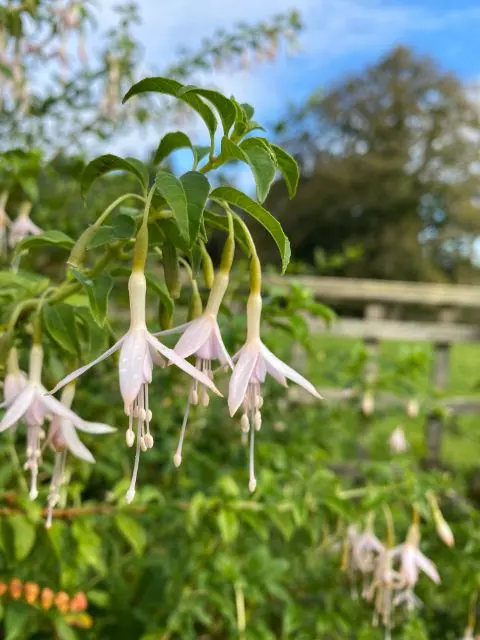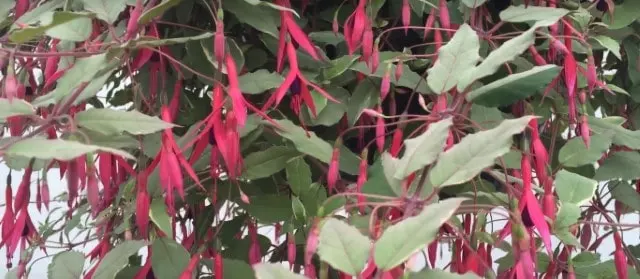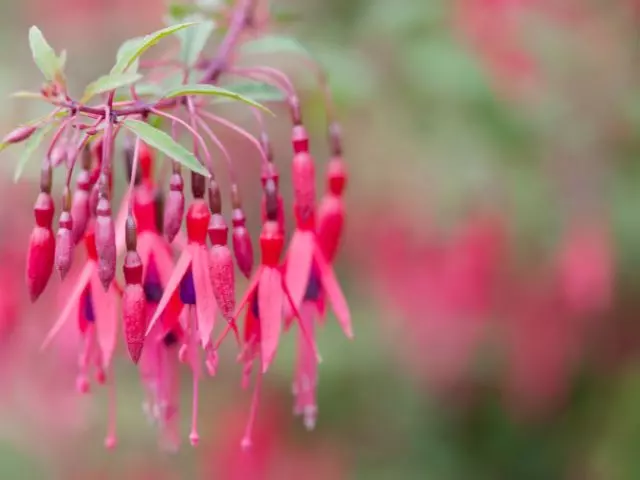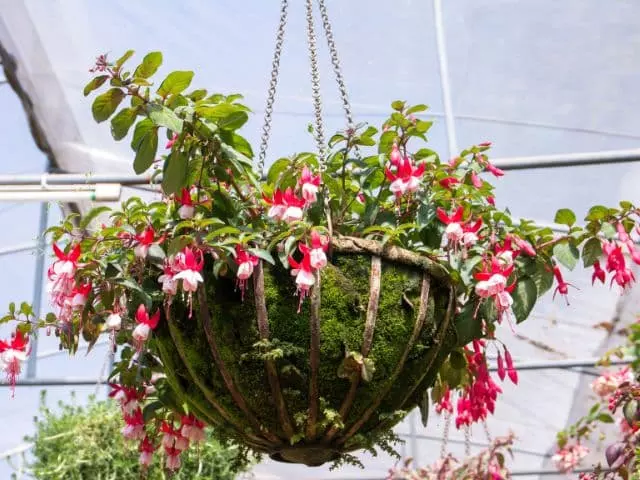For garden lovers who like to have beautiful flowers, I will take the opportunity to talk to you about the Fuchsia magellanica, also known as hummingbird fuchsia or hardy fuchsia. This plant attracts the attention of pollinating insects and hummingbirds because of its red and violet-hanging flowers. Also, let’s dig inside the most common Fuchsia magellanica varieties, such as Hawkshead, Versicolor, and Aurea.
Fuchsia magellanica is native to southern Argentina and Chile, known in those countries as chilco or aljaba, and forms part of the landscape of the humid and temperate forests of the south of both countries. Its scientific name is Fuchsia magellanica, and it belongs to the Onageraceae family, which includes some 650 species of herbaceous, shrubby, or climbing plants.
Table of Contents
Fuchsia magellanica Characteristics
Fuchsia magellanica is a shrub that can reach 10 ft (3 meters) in height, with thin and flexible branches. Its leaves are opposite, lanceolate, toothed, and dark green. Its flowers are tubular, with four red sepals and four violet petals, which open like a bell. The flowers are grouped in terminal clusters and appear from summer to autumn. Its fruit is an edible red or purple berry containing many small seeds.
Fuchsia magellanica is a plant highly appreciated for its ornamental value, as its flowers bring color and elegance to the garden. It adapts well to temperate and humid climates and resists moderate frosts. It prefers shady places with filtered light and fertile soils, well-drained and rich in organic matter.
Fuchsia magellanica can be grown in pots or on the ground, forming hedges or borders. It would be best to water frequently, but without waterlogging the substrate, and fertilize every 15 days during flowering. I would recommend pruning old or damaged branches after flowering to encourage the growth of new shoots.
Fuchsia magellanica Varieties
There are several varieties and cultivars of Fuchsia magellanica, each with unique characteristics. Here are some notable varieties:
Fuchsia magellanica Hawkshead
One of the most distinctive features of Fuchsia Hawkshead is its white flowers. Unlike the typical Fuchsia magellanica, which usually has pink or purple flowers, ‘Hawkshead’ produces pure white, pendulous blooms. These white flowers can create a striking contrast in the garden and stand out among other fuchsia varieties.
Fuchsia magellanica Hawkshead is known for its hardiness and can tolerate cooler temperatures, making it suitable for gardens in temperate climates. It can even withstand light frost, which is unusual for many fuchsia varieties.
While ‘Hawkshead’ may not have the typical bright colors that attract hummingbirds, it still has ornamental value. It can attract other pollinators like bees and butterflies due to its abundant white flowers. Read more about Do hummingbirds like fuchsia?

Fuchsia magellanica Versicolor
The most distinctive feature of Fuchsia Versicolor is its variegated foliage. The leaves are typically green with creamy-white or yellow margins. This variegation adds visual interest to the plant, even when it’s not blooming.
‘Versicolor’ produces the typical Fuchsia flowers with pink or reddish-pink sepals and purple petals. The flowers are tubular and pendulous, a characteristic shared with the species. It is a deciduous shrub reaching 4 to 5 feet (1.2 to 1.5 meters).
When designing a garden using Fuchsia magellanica Versicolor, use it as an ornamental shrub due to its variegated foliage and attractive flowers. It can be planted as a specimen plant, in mixed borders, or in containers to add visual interest and color to the landscape.

Fuchsia magellanica Aurea
The most striking characteristic of Fuchsia magellanica Aurea is its distinctive golden-yellow foliage. The leaves are bright golden-yellow, creating a stunning contrast with the typical green foliage of Fuchsia magellanica.
The tubular flowers of ‘Aurea’ are attractive to hummingbirds, making it a suitable choice if you want to create a garden that attracts these pollinators.
In garden designs, use Fuchsia magellanica Aurea for its ornamental value. Plant this Fuchsia Aurea variety in mixed borders or containers to add a bright pop of color to the landscape. The contrast between the yellow foliage and the colorful flowers makes it an eye-catching addition.

Frequently Asked Questions (FAQ)
Is Fuchsia Magellanica Evergreen?
Yes, Fuchsia magellanica is an evergreen. It is an evergreen plant that can reach more than 10 ft (3 meters) in height.
Can Fuchsias Be Grown Indoors?
Yes, fuchsias can be grown indoors, but they require specific care and conditions to thrive as indoor plants. Fuchsias require bright, indirect light when grown indoors. Place them near a south or west-facing window where they can receive plenty of bright, filtered sunlight.
Indoor temperatures around 60-70°F (15-24°C) are generally ideal for fuchsias. Avoid exposing them to extreme heat or cold drafts.

When to Prune Fuchsia Magellanica?
In regions with mild winters, you can often prune Fuchsia magellanica in late winter or early spring before new growth begins. That is an excellent time to remove dead or damaged branches and weak or leggy growth.
In areas with cold winters, waiting until after the last frost date in late spring or early summer before pruning is best. Pruning too early in these regions can stimulate new growth that may be vulnerable to frost damage.

